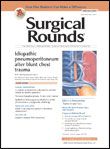One Step Closer to Identifying Post-op Atrial Fibrillation Causes, Prevention
As the complications of postoperative atrial fibrillation include stroke and longer hospital stays, surgeons have spent decades searching for cost-effective ways to prevent and treat the condition.

Heart surgery patients can experience postoperative atrial fibrillation (PAF) after mitral valve surgery, cardiac bypass surgery, or both. As the complications of PAF include stroke and longer hospital stays, surgeons have spent decades searching for cost-effective ways to prevent and treat the condition.
Previous studies demonstrated an inverse association between PAF and betaâ€blocker use; however, that suggests PAF’s underlying etiology is related to excessive sympathetic discharge and catecholamines.
Now, researchers at East Carolina University’s Brody School of Medicine have identified monoamine oxidase (MAO) as a major determinate of PAF and detailed their findings in a study published in the March 2014 issue of the Journal of American Heart Association.
The researchers examined human heart tissue samples obtained from 244 patients who underwent cardiac surgery between 2010 and 2012. They assessed reactive oxygen species (ROS) generation from multiple sources in the cardiac tissue and examined total glutathione (GSHt), GSH-peroxidase (GPx), and GSH-reductase (GR).
“What we found is that the enzyme responsible for metabolizing epinephrine and dopamine, MAO, is a strong predictor of whether a person will have atrial fibrillation after heart surgery,” said Ethan Anderson, PhD, the study’s principal investigator.
The researchers determined that MAO and nicotinamide adenine dinucleotide phosphate (NADPH) oxidase generated ROS at rates 10-fold greater than intact, coupled mitochondria. Additionally, they determined MAO activity varied 50â€fold among patients. Those with the highest level of MAO activity were significantly more likely to develop PAF. GPx was also associated with PAF, but the relationship was not linear.
The authors concluded that atrial MAO activity is an independent predictor of PAF. Their findings also supported the current theory that PAF’s etiology originates in atrial myocardium redox imbalance, such as oxidative stress.
